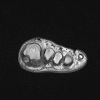Sesamoid osteonecrosis treated with radial extracorporeal shock wave therapy
- PMID: 28536215
- PMCID: PMC5753706
- DOI: 10.1136/bcr-2017-219191
Sesamoid osteonecrosis treated with radial extracorporeal shock wave therapy
Abstract
Sesamoid osteonecrosis is a disabling condition resulting in severe forefoot pain, for which there are limited treatment options. We present a 52-year-old man with 1-year history of pain, aggravated by walking and playing tennis. On examination, pain was localised to plantar aspect of the first metatarsophalangeal joint. Imaging revealed evolving end-stage avascular necrosis of lateral sesamoid with early secondary degenerative changes. Previous exhaustive conservative treatment had been unsuccessful in alleviating his pain. As an alternative to surgery, radial extracorporeal shock wave therapy (rESWT) was proposed. Treatment protocol was 2000 pulses at frequency of 5 Hz, and pressure was varied from 1.2 to 1.8 bar according to patient tolerance. A total of eight sessions were delivered. At completion of treatment, the patient reported minimal discomfort to no pain and was able to return to playing tennis with no recurrence. We propose rESWT to be an effective novel conservative treatment for sesamoid osteonecrosis.
Keywords: Orthopaedics; Sports and exercise medicine.
© BMJ Publishing Group Ltd (unless otherwise stated in the text of the article) 2017. All rights reserved. No commercial use is permitted unless otherwise expressly granted.
Conflict of interest statement
Competing interests: None declared.
Figures
Similar articles
-
Radial extracorporeal shock wave therapy is efficient and safe in the treatment of fracture nonunions of superficial bones: a retrospective case series.J Orthop Surg Res. 2017 Nov 6;12(1):164. doi: 10.1186/s13018-017-0667-z. J Orthop Surg Res. 2017. PMID: 29110711 Free PMC article.
-
Surgical treatment of AVN of the fibular (lateral) sesamoid.Foot Ankle Int. 2008 Feb;29(2):231-6. doi: 10.3113/FAI.2008.0231. Foot Ankle Int. 2008. PMID: 18315981
-
Arthroscopic Synovectomy and Excision of a Sesamoid in the Management of an Atypical Presentation of Avascular Necrosis of Bone: A Case Report.J Foot Ankle Surg. 2020 May-Jun;59(3):594-597. doi: 10.1053/j.jfas.2019.09.026. J Foot Ankle Surg. 2020. PMID: 32354515
-
Avascular Necrosis of the Sesamoids.Foot Ankle Clin. 2019 Mar;24(1):57-67. doi: 10.1016/j.fcl.2018.09.004. Foot Ankle Clin. 2019. PMID: 30685013 Review.
-
Hallux sesamoid disorders.Foot Ankle Clin. 2009 Mar;14(1):91-104. doi: 10.1016/j.fcl.2008.11.003. Foot Ankle Clin. 2009. PMID: 19232995 Review.
Cited by
-
Radial extracorporeal shockwave therapy (rESWT) for coccydynia: a prospective study of 14 patients.Ann Med Surg (Lond). 2023 Aug 4;85(10):4656-4661. doi: 10.1097/MS9.0000000000001133. eCollection 2023 Oct. Ann Med Surg (Lond). 2023. PMID: 37811013 Free PMC article.
-
Sesamoid Avascular Necrosis and Stress Fracture Treated with Core Decompression and Biologic Augmentation.Hawaii J Health Soc Welf. 2022 Mar;81(3 Suppl 1):16-18. Hawaii J Health Soc Welf. 2022. PMID: 35340940 Free PMC article.
-
Atraumatic Sport-Related Medial Sesamoid Pain: Conservative Treatment Outcome and Magnetic Resonance Imaging Features.Clin Orthop Surg. 2024 Aug;16(4):641-649. doi: 10.4055/cios24037. Epub 2024 Jun 4. Clin Orthop Surg. 2024. PMID: 39092304 Free PMC article.
-
Conservative Treatment of Sesamoiditis: A Systematic Literature Review with Individual-Level Pooled Data Analysis.Medicina (Kaunas). 2025 Jul 3;61(7):1215. doi: 10.3390/medicina61071215. Medicina (Kaunas). 2025. PMID: 40731844 Free PMC article. Review.
References
Publication types
MeSH terms
LinkOut - more resources
Full Text Sources
Other Literature Sources
Medical
Research Materials



